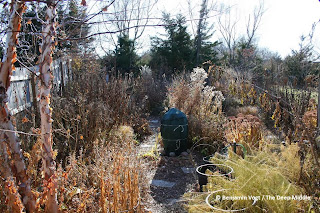Just as I felt while in school, my second career, if one can call it that -- perhaps a midlife crisis -- is landscapes, gardens, etc. The garden is my way of making sense of emotions and daily interactions outwardly, an echo of the words I write. But my background is from literature and philosophy, not generally recognized as practical tools to landscape design or thought except maybe by some of the diehard landscape theorists. I am a horticultural outsider.
When I researched and wrote my first memoir, Morning Glory, I read everything about the history of garden and landscape design, and much philosophy on nature (hundreds of books and articles). I got into the philosophies and cultural critiques of deep ecology and eco feminism, which inform the activist role I see needing to be in 21st century landscape design. As much as urban vegetable gardens and food forests are an act of defiance and a call to level the cultural / social playing field, I see gardens focused on native plants a leveling of the cultural / social playing field among all species. Or, an act of empowerment.
See, we're disconnected from the world. You'll argue we aren't -- why, you just took your dog for a walk in the park this morning. But nature is absent from our lives. We don't depend on it actively, only passively, and maybe this is why some in the field lament the lack of interest in the horticultural field. Nature is background. It has been diminished to an aesthetic. Oh, isn't that pretty? What a beautiful view. Such lovely colors. Want to know how to make a festive container for your front porch?
But my larger point is we think of gardens with words that can't begin to hold the deeper power inherent in nature: words like "beautiful" and "pretty" and "gorgeous" and, well, other adjectives that border on the abstract. Do we not have the language necessary to convey our true feelings, or do we lack true feelings in nature? Is it both? Is it a tributary from our ancestral fear of the world, and abstractions help keep us safe from imagined predators?
I think people -- especially younger people -- want landscapes that make them think, and when they think, they get connected. If gardens become not just something pretty, but also something that stands for a larger meaning directly applicable to everyday life and other social movements, then we have something.
 |
| Lincoln's Union Plaza can show & teach a lot more |
Why can't gardens do that? Why can't we create gorgeous gardens full of ecological processes that mimic even larger processes going on outside the garden's edges? This is place-conscious gardening on a much larger scale. This is, here in Nebraska, designing with native prairie plants. The plants will educate about local ecosystems and, ideally, connect people to their homeground in more meaningful ways. Often, these plants are completely unfamiliar, just as the call of a common blue jay is to my students, or the fact that we are tearing up the last prairies at a rate faster than before the dust bowl, or that with the loss of these prairies comes more social ills than you can shake a stick at.
Gardens, public and corporate, should be doing far more. They should be asking us to think while involving us in local culture and texture. They should be teaching us that nature is not a static pastoral painting that needs constant maintenance to keep it pristine, but that it shifts and evolves just like we do -- this will connect us to nature in profound ways. I'd also like to see public gardens that aren't destroyed at the "end of the season." If we're not gardening for all four seasons, we aren't connecting to place -- we're missing a solid 1/4 of our lives. We're also eroding some natural ecological process, a double teaching moment.
In talks I give and articles I write, I see a constant and growing desire to learn about both garden design and ecological processes, about the larger role designed landscapes play in a world we have now forced ourselves to tend as gardeners because we have our hand in everything -- climate change, industrial agriculture, logging, dams, the Pacific Ocean garbage patch full of plastic, et cetera. Since we are gardeners it behooves us to learn not just about aesthetics and good design, but the way in which garden spaces function to repair or create awareness of the need to repair larger ecosystems around us. When both sides of our brain become involved we are transformed -- the garden becomes an act of defiance as we reconnect and learn about the planet in ways many large corporations would prefer we didn't. When we garden with place in mind, we won't feel like outsiders, but will instead feel empowered. This is why we need to garden with native plants.







































